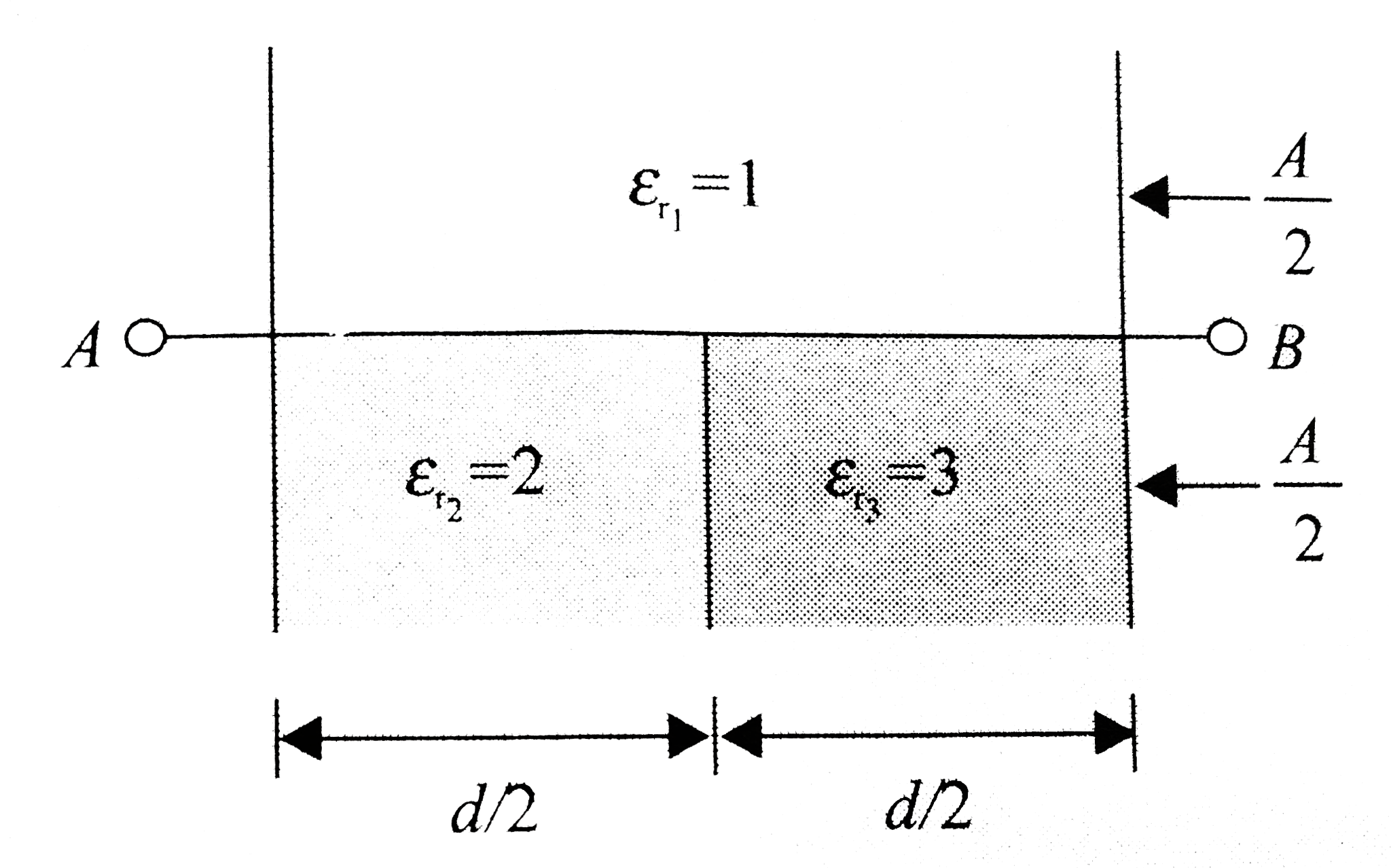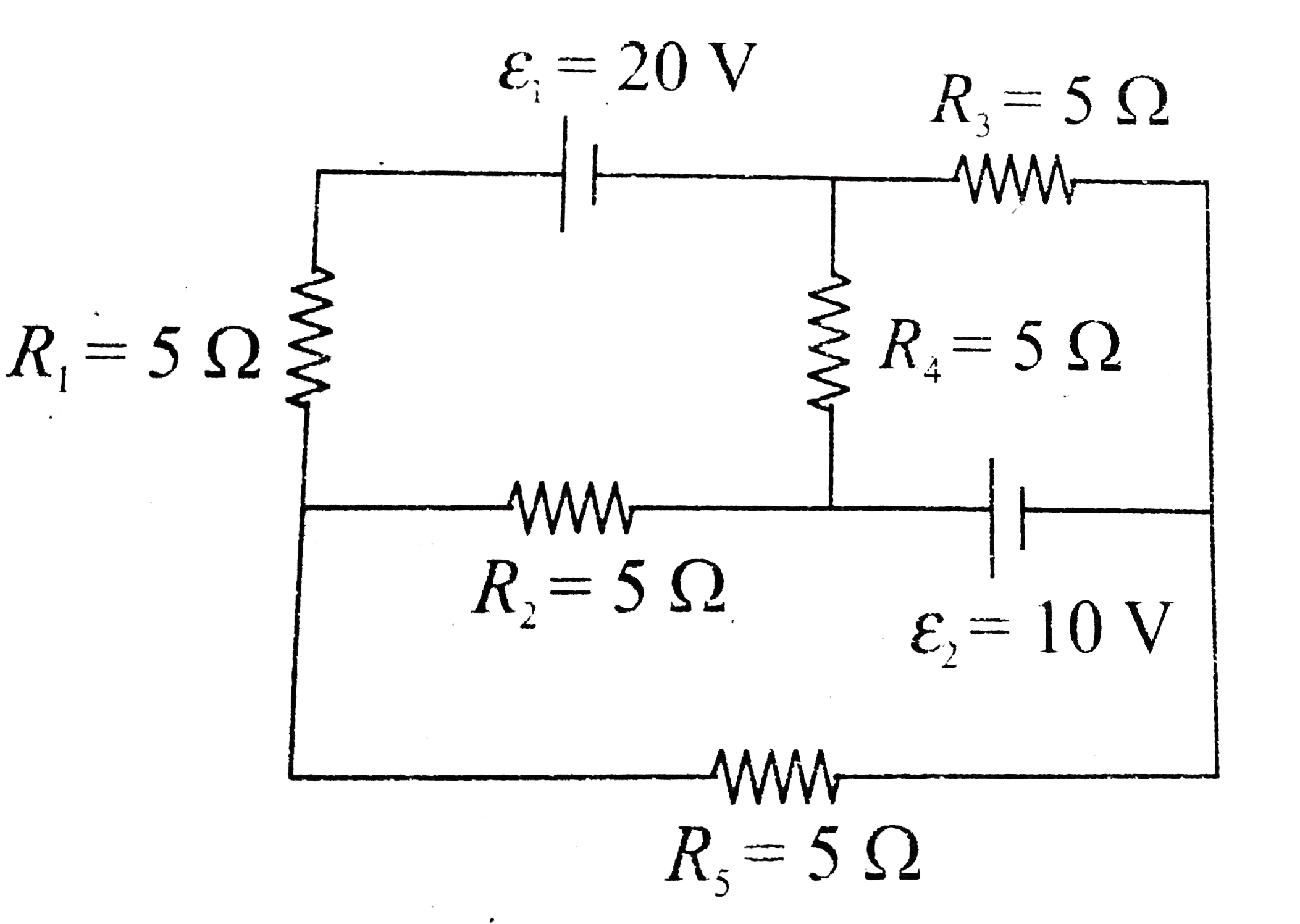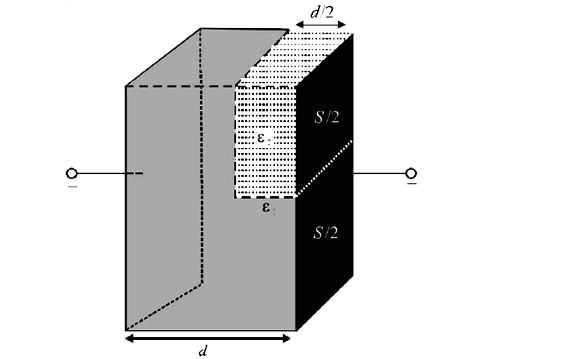Three dielectrics of relative permittivities εr1=1,εr2=2, and εr3=3
are introduced in a parallel plate capacitor of plate A and B.
 .
.
The given system can be made equivalent to two capcitors C1 and C2 in parallel.
For upper part
 ,
,
C1=ε0εr1(A2)d=ε0A2d
For lower part
C2=ε0(A2)d/2εr2+d/2εr2=ε0A/2d2(12+13)=6ε0A5d
Then CAB=C1+C2("because" C1 and C2 are in parallel)
=ε0A2d+6ε0A5d=17ε0A10d.
Similar Questions
Two dielectric slabs of relative oremittivities
εr1=2 and εr2=3 and thickness s=2d are filled in between the grounde plattery each of area A If a battery of emf ε is connected to the middle conducting plate, dind the
a. capacitance of the system,
b. charge flowing through the battery,
c. energy stored in the system.
 .
.
View SolutionDetermine current through batteries ε1 and ε2

View Solution
Knowledge Check
A parallel plate capacitor having plates of area S and plate separation d, has capacitance C1 in air. When two dielectrics of different relative primitivities (ε1=2 and ε2=4) are introduced between the two plates as shown in the figure, the capacitance becomes C2. The ratio C2C1 is
 A(a) 6/5B(b) 5/3C(c) 7/5D(d) 7/3
A(a) 6/5B(b) 5/3C(c) 7/5D(d) 7/3For the congiuration of mede of permittiveties epslon0,ε, and ε0 between parallel plates each of area A, as shown in the equivalent capacitance is .
 .Aε0AdBεε0A/dCεε0Ad(ε+ε0)Dεε0A(2ε+ε0)d.
.Aε0AdBεε0A/dCεε0Ad(ε+ε0)Dεε0A(2ε+ε0)d.The capacitance of a parallel plate condenser is C0 If a dielectric of relative permittivity εr and thickness equal to one fourth the plate separation is placed between the plates, then its capacity becomes C. The value of CC0 will be -
A5εr4εr+1B4εr3εr+1C3εr2εr+1D2εrεr+1
A double-layer cylindrical capacitor consists of conductors of radii R1 and R3 and two layers of dielectrics of relative permittivtties ε1 and esπon2. The radius of the common surface of the dielectrics. Is R2 . The breakdown field strengths of the dielectrics are E1 and E2 respectively. What is the breakdown voltage of this capacitor if (a) ε1R1E1<ε2R2E2 (b)ε2R2E2>ε1E1R1?
[Hint: If E1=E1max and E2>,E2max dielectric 1 will break first and if E2=E2max'E1>E1max dielectric 2 will break first.]
View SolutionThe gap between the plates of a parallel-plate capacitor is filled with istropic dielectrc whose permittlvity ε varies linearly from esπlon1 to ε2(ε2>ε1) in the direction perpendicular to the plates. The area of each plate equals S, the separation between the plates is equal to d. Find :
(a) the capacitance of the capacitor,
(b) the space density of the bound chagres as a function of a if the charge of the capacitor is q and E in it is directed toward the growing ε values.
View SolutionThe gap between the plates of a prallel-plate capacitor is filled up with two dielectric layers 1 and 2 thickness d1 and d2 permittivities ε1 and ε2 and resistivities ρ1 and ρ2. A dc voltage V is applied to the capacitor with electric field directed from layer 1 to layer 2 find σ the surface density of extraneous charges at the boundary between the dielectric layers and the condition under with σ=0.
View SolutionA system of two parallel plates, each of area A, are separated by distance d1 and d2. The space between them is filled with dielectrices of permitivities ε1 and ε)2. The permittivity of free space is ε0. The equivalent capacitance of the system is
View SolutionThe capacitance of a parallel plate condenser is C0 If a dielectric of relative permittivity εr and thickness equal to one fourth the plate separation is placed between the plates, then its capacity becomes C. The value of CC0 will be -
View Solution
